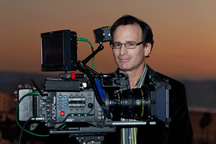Footage

In filmmaking and video production, footage is raw, unedited material as originally filmed by a movie camera or recorded by a (often special) video camera, which typically must be edited to create a motion picture, video clip, television show or similar completed work.
Footage may also refer to sequences used in film and
Since the term originates in film, footage is only used for recorded images, such as
History

The origin of the term "footage" comes from early
Types of footage
Film footage
Sometimes film projects will also sell or trade footage, usually second unit material not used in the final cut. For example, the end of the non-director's cut version of Blade Runner used landscape views that were originally shot for The Shining before the script was modified after shooting had finished.[2][3]
Television footage

Amateur video footage
Amateur footage is the low-budget
Stock footage
Footage brokers
A footage broker is an
See also
References
- ^ Engineers, Society of Motion Picture and Television (1917). Transactions of the Society of Motion Picture Engineers. Society of Motion Picture and Television Engineers.
- ^ Jagernauth, Kevin (11 December 2015). "Watch: U.S. Theatrical Ending To 'Blade Runner' That Features Footage From Stanley Kubrick's 'The Shining'". IndieWire. Retrieved 2017-06-12.
- ^ IMDb's Trivia page for Blade Runner. Retrieved July 3, 2009.
- ^ Amateur video playing greater role. News day.com. Retrieved July 3, 2009.
- ISBN 978-0690012040.
